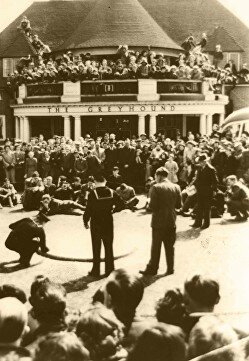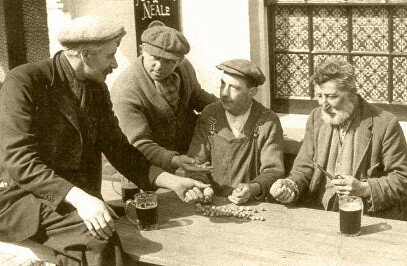Greyhound Marbles
Short History
Tinsley Green & the Marbles

The Greyhound Tinsley Green 1954
Tinsley Green & the Greyhound
In days gone by Tinsley was on the Surrey/Sussex Boarder with one side of Radford Road in each county. My friend Sally Burbridge (George’s daughter) once told me that she went to school in Horley, which is in Surrey but that if she was ill would go the Three Bridges, which is in Sussex. It was not until 1974 when Gatwick Airport was moved into Sussex that this anomaly was sorted out.
In the 1890s the road ran past the back of the present pub to a set of level crossing and then on to Crawley. The present day bridge and road was construed in early part of the twentieth century. Gatwick Airport was constructed on what was Hunts Green Farm in Tinsley Lane and the first Gatwick Airport railway station was built at Tinsley Green in the 1930s, long since gone, it was closed in 1958 but will always be remembered by locals as a location for one of the Beatles first film ‘A Hard Day’s Night’ in 1964. In the 1930s there was a small goods yard there as well and I have heard stories about the coal that would go missing from time to time and end up on local fires.

The Mellersh and Neale Brewery
The Mellersh and Neale Brewery was located at, 19 High Street, Reigate in Surrey and they owned the original Greyhound at Tinsley Green, when the marbles were first revived in 1932. This was not the present building but the old style cottage pub, which can still be seen to the right of today’s home of marbles. This long established brewery, dating back to the sixteenth century was famous for the quality of its beers praised in a drinking song,
Mr. Graham Neale from the brewing family was still supporting the championships right up to 1963; at that time he was the Managing Director of Friary Meux.
In 1936 Mellersh and Neale built the Greyhound we know today, when the new pub was completed it had the innovation of having three marbles rings set in the grounds ready for the next championship. In June 1938 the Meux Brewery Company, acquired Mellersh and Neale and in 1939 Meux and company presented the silver cup, which is still awarded, to the team champions to this day. It has all the team winners from 1939 to the present day engraved on it.
In 1956 came the merger with the Friary Holroyd and Healey’s Brewery Co. Ltd. from Guildford. The new name of Friary Meux arrived at Tinsley Green.
The 1960s were a time of considerable change in the brewing industry as one brewery after another merged, forming larger and larger companies. In 1961 Ind Coope, Tetley Walker and Ansells joined forces to form ICTA. In 1963 this group adopted the name Allied Breweries, and in 1964 took over Friary Meux Ltd and the Greyhound Hotel. Allied Breweries held the Greyhound until it sold all its licensed houses (pubs) to Punch Taverns in 1999. There was yet another change in 2002 when the Greyhound became part of the Sprit Group.
For hundreds of years the local inn was the focal point of village life, and so it was at the local inn that the Marbles revival began. It all started at the Greyhound, Tinsley Green in the early 1930s, after a break of almost fifty years.
The Marble Championships
Mr. F. Hannam, a chiropodist from the near by town of Horley was out with his wife in their pony and trap and they stopped for a lunch time drink at the Greyhound Hotel, which at this time was a smaller old style cottage pub. The cottage is still standing to day just at the edge of the present car park, between the New Greyhound and the main London - Brighton railway line. The brewery was a local one from Reigate, Melish and Neale the landlord was Mr. Alf Farrinton.

Players outside the Old Greyhound Circa 1935
In the public bar Mr. Hannam and his wife were talking with the landlord and some of the older local inhabitants of Tinsley Green, when the conversation turned to sport. Marbles is the game at Tinsley, he was told, we have played them here right up to a few years
ago - turn of the century or there about.
The story goes that Mrs Hannam, who was terminally ill, so enjoyed the day’s outing and the impromptu game of marbles, that in memory of his wife Mr. Hannam gave Alf Farrinton a silver cup to be played for at the Greyhound each year there after. (I HAVE BEEN TOLD BY SOME OF THE OLDER PLAYERS THAT THERE WAS NO CUP AVAIBLE WHEN IT CAME TO THE PRESENTATION AND THAT A SMALL TOBY JUG FROM BEHIND THE BAR WAS PRESSED IN TO SERVICE. THIS STORY SEEMS TO HAVE BEEN BORNE OUT BY EDGAR STANLEY GRANDDAUGHER, WHO TOLD ME THE FOLLOWING TALE. IT WOULD SEEM THAT WHEN EDGER ARRIVED HOME, LATE IN THE EVEING AND A LITTE WORSE FOR WARE, HOLDING A SMALL TOBY JUG IN HIS HAND, TELLING HIS WIFE HOW HE HAD WON THE JUG PLAYING MARBLES – HE WAS NOT BELIVED. MRS STANLEY WAS NOT IMPRESSED AND THOUGHT HE HAD COME BY IT DISHONSTLY, ORDERED EDGAR FROM THE HOUSE IN DISCRACE. EDGAR SPENT THE NEXT THREE DAYS SLEEPING IN THE SHEAD. IT WAS TWO DAYS AFTER THE CHAMPIONSHIPS THAT THE LOCAL VICAR SAW MRS STANLEY ANS ASKED IF SHE WAS PLEASED THAT HER HUSBAND HAD WON THE MARBLES AND THE LOVELY CUP. AFTER THIS EDGAR WAS FORGIVERN AND ALLOWED BACK IN TO THE HOUSE.)
The first of the revival matches took place on Good Friday 1932, Good Friday was the last day of the Sussex Marbles Season, as well as being the day locally to plant potatoes.
At first the games were played on the bear earth, a four foot ring being scribed in the ‘dirt’ with a bit of wood on the end of a longish piece of string. There were five teams that took part the first year; they were the Black Horse, Hookwood, Tinsley Green ‘A’ and ‘B’, Three Bridges and the Crawley Legion. This first attempt at organising a Marbles Championship was a bit shambolic; there was a mix-up with difference marble games and their various rules. One contemporary writer in a local news paper the West Sussex County Times said “To the uninitiated ‘marbles’ is a children’s game, but to those who really ‘play the game’ ‘marbles’ is a serious game with a language all its own and it was this that was missing on Good Friday”.
It seems not to have been a game, but a massacre, smash went the marbles as the flying ‘tolley’ struck them, and by delft manipulation, the ‘tolley’ was placed near the opposing ‘tolleys’ which were skilfully ‘killed’ in rotation, Crawley British Legion died first, then the two Tinsley teams and then Three Bridges. The second string then entered the list, but again the Black Horse triumphed. Flushed with excitement the captain of the leading team called up his third man, who ‘knuckled down’ to such good purpose that he sent four marbles flying, ‘killing’ all his opponents and his team was acclaimed champions.
There were no rules as such for the first championships, other than six marbles for each team, 30 marbles in the ring. In later years when each team consisted of six players it was decided that there should be four marbles for each member of the two teams plus one extra, making a total of 49 marbles in the centre of the ring. This meant that a draw could not take place, as there was an odd number of marbles to knock out.

You are viewing the text version of this site.
To view the full version please install the Adobe Flash Player and ensure your web browser has JavaScript enabled.
Need help? check the requirements page.